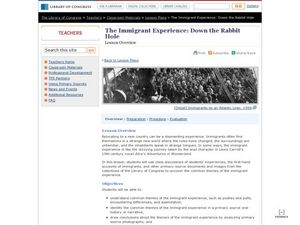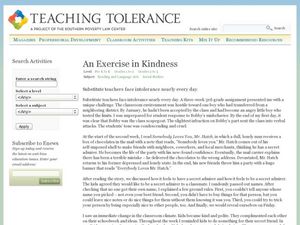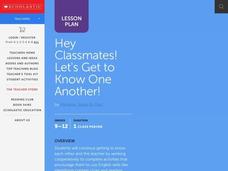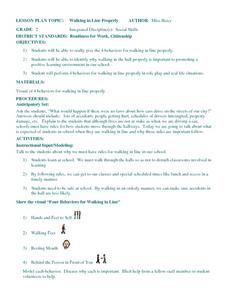Nemours KidsHealth
Human Body Series: Immune System
When you work with school children, teaching about immunity and illness prevention is a priority! This approach includes a discussion, kid-friendly online articles, a creative writing assignment, and a quiz on the role of leukocytes and...
Curated OER
Gingerbread Man
Students visit new places in the school and meet new people as they look for the Gingerbread Boy. They use different locomotor movements to get to different locations.
Curated OER
Metamorphosis Magic
Students play rock-paper-scissors and create a play to demonstrate the butterfly life cycle. In this butterfly life cycle lesson plan, students also plant a butterfly garden with plants that attract butterflies.
Curated OER
Observation
Students practice observation skills by discussing physical attributes of family artifacts. They determine what characteristics of an object are considered important details.
Nemours KidsHealth
Food Allergies: Grades K-2
Students explore different types of food allergies. In this food allergy lesson, students look at what foods people with peanut, seafood, milk, egg, soy or wheat allergies have to avoid. They create a button for a student with an allergy...
Curated OER
Conversions: Metrics Made Easy
Students, in groups, measure and record each other's height. They identify measurement conversion methods and use online resources to convert measured heights to multiple systems.
Curated OER
The Immigrant Experience: Down the Rabbit Hole
Young scholars relate the immigrant experience to Lewis Carroll's Alice's Adventures in Wonderland. In this immigration experience lesson, students read Lewis Carroll's Alice's Adventures in Wonderland and relate it to the immigrant...
Curated OER
Acid Mine Drainage
Students use cabbage, backing soda, cobblestones, and more to test the acid in the water. In this acid mine damage lesson plan, students complete 13 experiments to test and treat acid.
Curated OER
Know Your Energy Costs
Students calculate energy costs using a formula and complete a cost chart. In this energy costs lesson, students analyze the cost of electrical energy and find ways to conserve it.
Curated OER
Family Ties
Students explore what life is like for immigrant women in the United States. In this immigration lesson, students study about immigration through reading and watching a video, then share their thoughts and ideas by participating in an...
Curated OER
Refugees at Center Stage
What is an advocate? Help high schoolers understand the issues forcing refugees to leave their home country. After gaining some information on the subject, high schoolers create a dynamic presentation and persuasive essay encouraging...
Curated OER
An Exercise in Kindness
Although this resource is not a traditional lesson plan, it does explain an activity for creating a safe and supportive environment while teaching young learners the importance of being kind to one another. Start bt reading the...
Curated OER
Literary Terms
"Is that your final answer?" Challenge and thrill your class with this language arts game, which is based on "Who Wants to Be a Millionaire." The game covers literary terms such as point of view, alliteration, and protagonist, and is...
Curated OER
Hey Classmates! Let's Get to Know One Another!
Two word puzzles encourage collaboration among learners. One sheet has numbers and initials that show a relationship and the other has pictorial images that represent a phrase. Partners cooperate in order to develop functional working...
Curated OER
Chocolate Fever
Students study plants in the rainforest. They complete a variety of activities surrounding the subject of chocolate. They create new candy bars, invent learning games and write poetry--all focusing on chocolate.
Curated OER
Walking in Line Properly
Students discuss what would happen if there were no driving safety laws, orally state four behaviors for walking properly in line, identify why walking in hall properly is important to promote positive learning environment, and perform...
Curated OER
Latinos and the Fourteenth Amendment: A Primary Source Document Activity
Eighth graders explore the effect of the Fourteenth Amendment. In this US History lesson, 8th graders read and analyze primary source documents. Students write a three minute paper demonstrating their understanding of the fourteenth...
Curated OER
Environment: Fishing and Property Rights
Students participate in a role-playing "fishing game" to discover how over-harvesting can eliminate a resource. In the second round of the game, students are told they can only fish in their assigned territories.
Students explain the...
Curated OER
Conversions: Metrics Made Easy
Students convert standard units of measurement to metric units using tape measures, meter sticks, rulers, and online conversion calculators.
Curated OER
Bartering, an Early Form of Interdependence
Students explore the the benefits and problems associated with a barter system in the Colonies and trace its relationship to the development of interdependence that this system creates. An experience of bartering is created in this lesson.
Curated OER
Stage a Debate: A Primer for Teachers (Lincoln-Douglas Debate Format)
For a comprehensive overview of debate styles and formats, look at this resource. It details the Lincoln-Douglas debate format (one-to-one debate with specific, timed rounds of points, cross-examination, and rebuttals). You can also find...
Oakwood Publishing
Workshop 4: Constitutional Convention
How do new amendments become part of the US Constitution? AP government students explore, analyze, and use the US Constitution to develop a deep understanding of the interworkings of law and government while practicing synthesis and...
Curated OER
Snowflake Bentley
Learners explore crystals through the story Snowflake Bentley and then create crystal pictures of their own. In this interdisciplinary lesson, they create a crystal web chart on chart paper, design artificial snowflakes, and write poems...
Curated OER
What Class Are You In?
Classifying animals has never been this much fun! Pupils discuss the animal groups, fish, reptiles, amphibians, mammals, birds, and also identify their characteristics. Then, they take pictures of animals and classify them in a group...

























